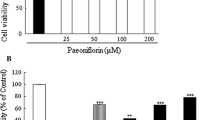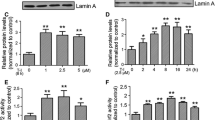Abstract
We have investigated the mechanism of shikonin function on protection of dopaminergic neurons against 6-OHDA-induced neurotoxicity. Treatment of rat pheochromocytoma cell line PC12 by serial dilutions of shikonin determined 10 μM of the compound as its optimum concentration for protection saving nearly 70 % of the cells against toxicity. Reverse transcription-PCR analysis of shikonin-treated cells showed threefold increase in mRNA levels of glutathione peroxidase-1 (GPX-1) as a representative component of the intracellular anti-oxidant defense system. To elucidate shikonin-GPX1 relationships and maximize protection, we transduced PC12 cells using recombinant lentivirus vectors that harbored GPX-1 coding sequence. This change upregulated GPX-1 expression, increased peroxidase activity and made neuronal cells resistant to 6-OHDA–mediated toxicity. More importantly, addition of shikonin to GPX1-overexpressing PC12 cells augmented GPX-1 protein content by eightfold leading to fivefold increase of enzymatic activity, 91 % cell survival against neurotoxicity and concomitant increases in intracellular glutathione (GSH) levels. Depletion of intracellular GSH rendered all cell groups highly susceptible to toxicity; however, shikonin was capable of partially saving them. Subsequently, GSH-independent superoxide dismutase mRNA was found upregulated by shikonin. As signs of apoptosis inhibition, the compound upregulated Bcl-2, downregulated Bax, and prevented cell nuclei from undergoing morphological changes typical of apoptosis. Also, a co-staining method demonstrated GPX-1 overexpression significantly increases the percent of live cells that is maximized by shikonin treatment. Our data indicate that shikonin as an antioxidant compound protects dopaminergic neurons against 6-OHDA toxicity and enhances their survival via both glutathione-dependent and direct anti-apoptotic pathways.







Similar content being viewed by others
References
Browne RW, Armstrong D (1998) Reduced glutathione and glutathione disulfide. In: Armstrong D (ed) Free radical and anti-oxidant protocols. Humana Press, Totowa, pp 347–352
Cederberg J, Galli J, Luthman H, Eriksson UJ (2000) Increased mRNA Levels of Mn-SOD and catalase in embryos of diabetic rats from a malformation- resistant strain. Diabetes 49:101–107
Chelikani P, Fita I, Loewen PC (2004) Diversity of structures and properties among catalases. Cell Mol Life Sci 61(2):192–208
Chen CH, Lin ML, Ong PL, Yang JT (2012) Novel multiple apoptotic mechanism of shikonin in human glioma cells. Ann Surg Oncol 19(9):3097–3106
Cheng W, Fu YX, Porres JM, Ross DA, Lei XG (1999) Selenium-dependent cellular glutathione peroxidase protects mice against a pro-oxidant-induced oxidation of NADPH, NADH, lipids, and protein. FASEB J 13:1467–1475
Chou TF, Ma MC, Tsai CP, Chen CF (2009) Enhancement of superoxide dismutase activity in rat lungs after hypoxic preconditioning. Chin J Physiol 52(5 Supplement):376–383
Dexter D, Wells F, Lees AG, Agid F, Agid Y, Jenner P, Marsden CD (1989) Increased nigral iron content and alterations in other metal ions occurring in brain in Parkinson’s disease. J Neurochem 52:1830–1836
Federico A, Cardaioli E, Da Pozzo P, Formichi P, Gallus GN, Radi E (2012) Mitochondria, oxidative stress and neurodegeneration. J Neurol Sci 322:254–262
Fridovich I (1998) The trail to superoxide dismutase. Protein Sci 7(12):2688–2690
Gao D, Kakuma M, Oka S, Sugino K, Sakurai H (2000) Reaction of beta-alkannin (shikonin) with reactive oxygen species: detection of beta-alkannin free radicals. Bioorg Me Chem 8:2561–2569
Gardaneh M, Gholami M, Maghsudi N (2011) Synergy between glutathione peroxidase-1 and astrocytic growth factors suppresses free radical generation and protects dopaminergic neurons against 6-hydroxydopamine. Rejuven Res 14:195–204
Gharib E, Gardaneh M, Shojaei S (2013) Upregulation of glutathione peroxidase-1 expression and activity by glial cell line-derived neurotrophic factor promotes high-level protection of PC12 cells against 6-OHDA and H2O2 toxicities. Rejuven Res (In press)
Halliwell B, Gutteridge JM (1992) Biologically relevant metal ion-dependent hydroxyl radical generation. An update. Febs Lett 307:108–112
Hastings TG (2009) The role of dopamine oxidation in mitochondrial dysfunction: implications for Parkinson’s disease. J Bioenerg Biomembr 41:469–472
Hirsch EC, Faucheux B, Damier P, Mouatt-Prigent A, Agid Y (1997) Neuronal vulnerability in Parkinson’s disease. J neural Trans 50:79–88
Hisa T, Kimura Y, Takada K, Suzuki F, Takigawa M (1998) Shikonin, an ingredient of Lithospermum erythrorhizon, inhibits angiogenesis in vivo and in vitro. Anticancer Res 18:783–790
Hsu PC, Huang YT, Tsai ML, Wang YJ, Lin JK, Pan MH (2004) Induction of apoptosis by shikonin through coordinative modulation of the Bcl-2 family, p27, and p53, release of cytochrome c, and sequential activation of caspases in human colorectal carcinoma cells. J Agric Food Chem 52(20):6330–6337
Kinouchi S (2003) Changes in apoptosis-related genes (Bcl-2, Bax) in the urethras of old female rats following estrogen replacement. Yonago Acta Medica 46:109–115
Kourounakis AP, Assimopoulou AN, Papageorgiou VP, Gavalas A, Kourounakis PN (2002) Alkannin and shikonin: effect on free radical processes and on inflammation - a preliminary pharmacochemical investigation. Arch Pharm 335:262–266
Lei XG, Cheng W-H, McClung JP (2007) Metabolic regulation and function of glutathione peroxidase-1. Annu Rev Nutr 27:41–61
Moscow JA, Morrow CS, He R, Mullenbach GT, Cowan KH (1992) Structure and function of the 5′-flanking sequence of the human cytosolic selenium-dependent glutathione peroxidase gene (hgpx1). J Biol Chem 267:5949
Napolitano A, Crescenzi O, Pezzella A, Prota G (1995) Generation of the neurotoxin 6-hydroxydopamine by peroxidase/H2O2 oxidation of dopamine. J Med Chem 38:917–922
Papageorgiou VP, Assimopoulou AN, Ballis AC (2008) Alkannins and shikonins: a new class of wound healing agents. Curr Med Chem 15(30):3248–3267 Review
Safi R, Gardaneh M, Panahi Y, Maghsoudi N, Zaefizadeh M, Gharib E (2012) Optimized quantities of GDNF overexpressed by engineered astrocytes are critical for protection of neuroblastoma cells against 6-OHDA toxicity. J Mol Neurosci 46:654–665
Smythies J, Galzigna L (1998) The oxidative metabolism of catecholamines in the brain: a review. Biochem Biophys Acta 1380:159–162
St. Clair DK, Chow CK (1996) Glutathione peroxidase: activity and steady-state level of mRNA. In: Punchard NA, Kelly FJ (eds) Free radicals. IRL Press, Oxford, pp 227–240
Tanaka S, Tajima M, Tsukada M, Tabata M (1986) A comparative study on antiinflammatory activities of the enantiomers, shikonin and alkannin. J Nat Prod 49:466–469
Wang Z, Liu T, Gan L, Wang T, Yuan X, Zhang B et al (2010) Shikonin protects mouse brain against cerebral ischemia/reperfusion injury through its antioxidant activity. Eur J Pharmacol 643:211–217
Xiong W, Luo G, Zhou L, Zeng Y, Yang W (2009) In vitro and in vivo antitumor effects of acetylshikonin isolated from Arnebia euchroma (Royle) Johnst (Ruanzicao) cell suspension cultures. Chin Med 4:14
Yao Y, Brodie AMH, Kensler TW, Zhou Q (2010) Inhibition of estrogen signaling activates the NRF2 pathway in breast cancer. Breast Cancer Res Treat 124(2):585–591
Yoshimi N, Wang A, Morishita Y, Tanaka T, Sugie S, Kawai K et al (1992) Modifying effects of fungal and herb metabolites on azoxymethane-induced intestinal carcinogenesis in rats. Jpn J Cancer Res 83:1273–1278
Zhang B, Chen N, Chen H, Wang Z, Zheng Q (2012) The critical role of redox Homeostasis in Shikonin-Induced HL-60 cell differentiation via unique modulation of the Nrf2/ARE Pathway. Oxid Med Cell Longev, Article ID 781516, doi:10.1155/2012/781516
Zhao W, Shen Y, Ren S (2011) Endogenous expression of Neuregulin-1 (Nrg1) as a potential modulator of prolactin (PRL) secretion in GH3 cells. Cell Tissue Res 344:313–320
Zhou LJ, Zhu XZ (2000) Reactive oxygen species-induced apoptosis in PC12 cells and protective effect of bilobalide. J Pharmacol Exp Ther 293:982–988
Zhou C, Huang Y, Przedborski S (2008) Oxidative stress in Parkinson’s disease. Ann NY Acad Sci 1147:93–104
Acknowledgments
This study was supported by a Grant (420) from NIGEB.
Conflict of interest
The authors declare no conflict of interest
Author information
Authors and Affiliations
Corresponding author
Rights and permissions
About this article
Cite this article
Esmaeilzadeh, E., Gardaneh, M., Gharib, E. et al. Shikonin Protects Dopaminergic Cell Line PC12 Against 6-Hydroxydopamine-Mediated Neurotoxicity Via Both Glutathione-Dependent and Independent Pathways and by Inhibiting Apoptosis. Neurochem Res 38, 1590–1604 (2013). https://doi.org/10.1007/s11064-013-1061-9
Received:
Revised:
Accepted:
Published:
Issue Date:
DOI: https://doi.org/10.1007/s11064-013-1061-9




